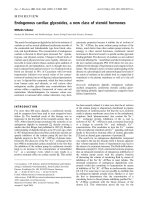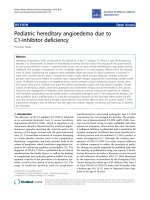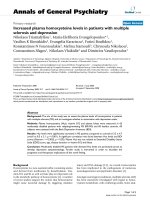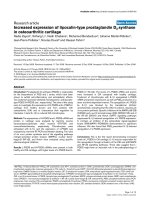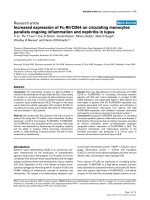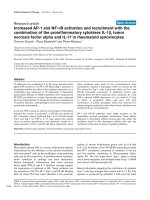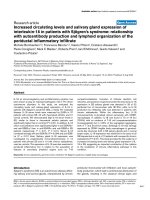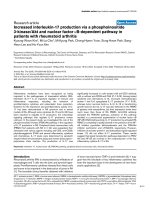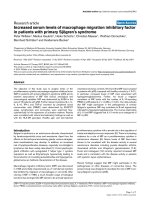Báo cáo y học: "Increased cardiac index due to terbutaline treatment aggravates capillary-alveolar macromolecular leakage in oleic acid lung injury in dogs" docx
Bạn đang xem bản rút gọn của tài liệu. Xem và tải ngay bản đầy đủ của tài liệu tại đây (503.22 KB, 9 trang )
Open Access
Available online />Page 1 of 9
(page number not for citation purposes)
Vol 13 No 5
Research
Increased cardiac index due to terbutaline treatment aggravates
capillary-alveolar macromolecular leakage in oleic acid lung injury
in dogs
Raphael Briot, Sam Bayat, Daniel Anglade, Jean-Louis Martiel and Francis Grimbert
Laboratoire TIMC, Equipe PRETA, Unité Mixte de Recherche 5525 du Centre National de Recherche Scientifique, Université Joseph Fourier, Centre
Hospitalier Universitaire, Grenoble, 38043 cedex 09, France
Corresponding author: Raphael Briot,
Received: 2 Sep 2009 Revisions requested: 23 Sep 2009 Revisions received: 30 Sep 2009 Accepted: 21 Oct 2009 Published: 21 Oct 2009
Critical Care 2009, 13:R166 (doi:10.1186/cc8137)
This article is online at: />© 2009 Briot et al.; licensee BioMed Central Ltd.
This is an open access article distributed under the terms of the Creative Commons Attribution License ( />),
which permits unrestricted use, distribution, and reproduction in any medium, provided the original work is properly cited.
Abstract
Introduction We assessed the in vivo effects of terbutaline, a
beta2-agonist assumed to reduce microvascular permeability in
acute lung injury.
Methods We used a recently developed broncho-alveolar
lavage (BAL) technique to repeatedly measure (every 15 min. for
4 hours) the time-course of capillary-alveolar leakage of a
macromolecule (fluorescein-labeled dextran) in 19 oleic acid
(OA) lung injured dogs. BAL was performed in a closed lung
sampling site, using a bronchoscope fitted with an inflatable
cuff. Fluorescein-labeled Dextran (FITC-D70) was continuously
infused and its concentration measured in plasma and BAL fluid.
A two-compartment model (blood and alveoli) was used to
calculate KAB, the transport rate coefficient of FITC-D70 from
blood to alveoli. KAB was estimated every 15 minutes over 4
hours. Terbutaline intra-venous perfusion was started 90 min.
after the onset of the injury and then continuously infused until
the end of the experiment.
Results In the non-treated injured group, the capillary-alveolar
leakage of FITC-D70 reached a peak within 30 minutes after the
OA injury. Thereafter the FITC-D70 leakage decreased
gradually until the end of the experiment. Terbutaline infusion,
started 90 min after injury, interrupted the recovery with an
aggravation in FITC-D70 leakage.
Conclusions As cardiac index increased with terbutaline
infusion, we speculate that terbutaline recruits leaky capillaries
and increases FITC-D70 leakage after OA injury. These findings
suggest that therapies inducing an increase in cardiac output
and a decrease in pulmonary vascular resistances have the
potential to heighten the early increase in protein transport from
plasma to alveoli within the acutely injured lung.
Introduction
Acute lung injury (ALI) is a major syndrome in patients in the
intensive care unit, and it has a high mortality rate. An
increased capillary-alveolar permeability to plasma proteins is
an early marker of the acute phase of lung injury andcontrib-
utes to the development of fibroproliferation [1]and lung fibro-
sis, which both contribute to a negative outcome [2]. Plasma
proteins that flood the alveoli include pro-coagulant factors
and initiate a local coagulation cascade [3]. A relation
between the early alteration of capillary-alveolar permeability
to proteins and the fibrotic process has been confirmed in clin-
ical studies [4]. The finding that in acute respiratory distress
syndrome (ARDS) patients, bronchoalveolar lavage (BAL) pro-
tein levels decreased over time only in survivors suggests the
involvement of the amplification of inflammatory responses
due to alveolar protein flooding [5]. If a high BAL protein con-
centration in patients with ARDS predicts a higher risk of late
fibrosis, any therapy aimed at reducing plasma protein accu-
mulation in the interstitium and alveoli is of potential benefit.
ABP: systemic arterial blood pressure; ALI: acute lung injury; ALTA: AlbuteroL for the Treatment of ALI; ANOVA: analysis of variance; ARDS: acute
respiratory distress syndrome; BAL: broncho-alveolar lavage; BALTI: Beta-Agonist Lung Injury Trial; CO: cardiac output; FiO2: fraction of inspired
oxygen; FITC-D70: fluorescein-labeled dextran; Hcl: Hydrochloric acid; K
AB
: coefficient of capillary-alveolar leakage; OA: oleic acid; PaO2: partial
pressure of oxygen in arterial blood; PAOP: pulmonary arterial occlusion pressure; PAP: pulmonary arterial blood pressure; Pcap: pulmonary capillary
pressure; PET: Positron emission tomography; PVR: total pulmonary vascular resistances; SEM: standard error of the mean; SpO2: pulsed oxygen
saturation; Vtn: volume of the lavaged lung segment.
Critical Care Vol 13 No 5 Briot et al.
Page 2 of 9
(page number not for citation purposes)
We recently developed a modified BAL technique to monitor
the capillary-alveolar leakage of macromolecules over several
hours [6]. This technique allows the assessment of therapies
aimed at slowing plasma protein accumulation in alveoli.
Several studies suggest a potential role for β2-agonists in the
treatment of ARDS. These agents have been shown to reduce
pulmonary neutrophil sequestration and activation, enhance
surfactant secretion and modulate the inflammatory and coag-
ulation cascades [7,8]. β2-adrenergic agonists have shown
ability to reduce lung endothelial injury [9]and they are well
known for their ability to enhance the epithelial fluid reabsorp-
tion by stimulating the activity and the expression of the epithe-
lial sodium channels [10]. However, the results of clinical
studies on β2-agonists effects in ARDS are controversial. The
Beta-Agonist Lung Injury Trial (BALTI) [11]showed that intra-
venous albuterol treatment reduces extravascular lung water in
patients with ARDS; but the recent study "AlbuteroL for the
Treatment of ALI" (ALTA) [12] failed to find a beneficial effect
of aerosolized albuterol therapy in a large randomized, pla-
cebo-controlled trial. Also, several in vivo studies showed no
beneficial effects of β2-agonist therapy, in terms of protein
accumulation in injured lungs [13,14]. Hemodynamic effects
of β2-agonists may interfere with other potentially beneficial
effects and may explain some of these contradictory results in
patients with lung injury [15].
The goal of the present study was therefore to evaluate the
effects of terbutaline, a widely used β2-agonist, on the early
increase in macromolecular permeability of the capillary-alveo-
lar barrier following lung injury. We used a well-known in vivo
dog model of oleic acid (OA) lung injury in which we assessed
the overall effect of terbutaline, both on protein leakage
through the capillary-alveolar barrier and on pulmonary
hemodynamics.
Materials and methods
Animal preparation
The experiments were performed on 19 anesthetized dogs.
The experiments were carried out in accordance with the
applicable French and European Community regulations. Ani-
mals were intubated and mechanically ventilated using 2%
halothane to maintain anesthesia. Tidal volume was 10 mL/kg
and respiratory frequency was adjusted between 12 and 20
breathes/minute to keep end-tidal CO
2
within normal range.
Fraction of inspired oxygen (FiO
2
) was adjusted to keep hemo-
globin oxygen saturation above 95%, as measured by pulse
oxymetry (SpO
2
). Arterial blood gases were measured every
hour following a 10-minute period of ventilation with an FiO
2
of
100%.
In injury experiments, animals were equipped with a pulmonary
artery catheter and a catheter in the femoral artery. The follow-
ing parameters were recorded: systemic arterial blood pres-
sure (ABP), pulmonary arterial blood pressure (PAP),
pulmonary arterial occlusion pressure (PAOP), and cardiac
output (CO). Pulmonary capillary pressure (Pcap) was esti-
mated from the back-extrapolation of the transitory pressure
drop (between 0.2 and 2 seconds) following the inflation of
the balloon of the pulmonary arterial catheter, using a double-
exponential fit [16]. As control animals were destined for other
later experiments, they were not equipped with invasive
catheters.
Broncho-alveolar lavage procedure
This modified BAL technique has been extensively described
in a previous publication [6]. Briefly, in order to perform
repeated BAL in a closed lung segment, an inflatable balloon
was adapted to the extremity of a bronchoscope. Six initial
BAL cycles were performed sequentially, in order to obtain a
rapid saturation of the lavaged lung segment. Thereafter, one
BAL cycle was performed every 15 minutes for the next three
hours.
Sample processing
Prior to the procedure, a batch solution of 500 mL of fresh lav-
age fluid was prepared by adding
125
I-albumin (Cis Bio Inter-
national, Paris, France) to saline (NaCl: 0.9 g %) at a final
activity of 5 μCi/L as a dilution indicator of the lavage fluid
inside the lung.
Thirty minutes before BAL, a 6 mg/kg bolus of a fluorescein
isothiocyanate-labeled dextran (FITC-D70; average molecular
mass, 73,100 daltons; Sigma, St. Quentin Fallavier, France)
was injected, followed by an infusion of 6 mg/kg/hour in order
to obtain a steady FITC-D70 concentration in plasma. Indica-
tor concentrations were measured after the experiment.
125
I-
albumin activity was measured in BAL. FITC-D70 concentra-
tions were measured in plasma and BAL fluid by fluorescence
spectrophotometry, using excitation and emission wave-
lengths of 482 and 521 nm, respectively. The data analysis
was performed using a two-compartment model where the
FITC-D70 transport rate coefficient K
AB
(min
-1
) from blood to
alveoli was estimated (see details of calculations in Additional
data file 1).
Experimental protocol
The study was performed in four separate groups.
In group 1 (n = 3) control animals were not injured with OA
and received no terbutaline. In group 2 (n = 3) animals were
not injured but received a terbutaline treatment.
In groups 3 and 4 the ALI was induced 30 minutes after the
initial saturation BAL procedure. Every two minutes, 0.3 ml
boluses of OA were injected into the superior vena cava
through the proximal lumen of the pulmonary artery catheter up
to a total dose of 0.08 ml/kg. Group 3 (n = 7) received OA
injury without any treatment. In group 4 (n = 6) the terbutaline
treatment was administered using an infusion of 0.25 mg/kg/
Available online />Page 3 of 9
(page number not for citation purposes)
min started 90 minutes after OA injury. Thereafter the terbuta-
line was continuously infused until the end of the experiment.
Statistics
A statistical analysis was performed through Statview soft-
ware (SAS Institute Inc. Cary, NC, USA). Group data are sum-
marized as the mean ± standard error of the mean (SEM). First
we compared global data by analysis of variance (ANOVA).
Thereafter intra-group data were compared using a post-hoc
test of Tukey-Kramer. Mann-Whitney rank-sum tests were
used for two-group comparisons. We used linear regression
models to determine individual correlations between K
AB
and
hemodynamic data. Differences with a P < 0.05 were consid-
ered as significant.
Results
The volume of the lavaged lung segment (Vtn) remained stable
(63.1 ± 3.1 mL) throughout the sequential lavage cycles. The
FITC-D70 plasma concentration was also stable throughout
the experiment (0.15 ± 0.01 mg/mL).
The alveolar concentration of FITC-D70 remained near zero in
all groups before the onset of the injury. In injured animals
(groups 3 and 4), the alveolar FITC-D70 concentration rose
immediately after the OA infusion. In group 3 (OA) the FITC-
D70 concentration reached a plateau during the last hour of
the experiment, whereas in group 4 (OA + terbutaline) the
start of terbutaline perfusion was followed by a second rise in
BAL FITC-D70 concentration (Figure 1).
Coefficient of capillary-alveolar leakage (K
AB
)
The FITC-D70 capillary-alveolar transport rate coefficient from
blood to alveoli (K
AB
) was near zero in groups 3 and 4 before
OA injury, a period defined as steady state.
Although K
AB
remained near zero in control groups 1 and 2
throughout the experiment, this coefficient rose markedly in
OA-injured animals (groups 3 and 4) immediately after the
onset of injury. K
AB
reached a peak value (peak of injury) 30
minutes after the OA infusion and decreased gradually there-
after. Within this recovery period, we distinguished two
phases: early recovery (first 45 minutes after the peak of injury)
and late recovery (last hour of the experiment).
In group 3 (OA injury) K
AB
recovered slowly, while in group 4
(OA + terbutaline) K
AB
rose again after the onset of terbutaline
administration (Figure 2).
Hemodynamics values
In group 4 (OA + terbutaline) the cardiac index and the PAP
increased and remained elevated following terbutaline admin-
istration. Such an increase was not observed in group 3 (OA).
Total pulmonary vascular resistances (PVR) increased after
OA injury and remained elevated in non-treated animals (group
3). Terbutaline infusion reduced the elevated PVR approxi-
mately to the pre-injury level. The hematocrit was constant
throughout the experiment (mean value, 0.36 ± 0.1) with no
significant difference between the different groups. The partial
pressure of arterial oxygen (PaO
2
)/FiO
2
ratio decreased mark-
edly at the onset of the injury and did not recover later. There
Figure 1
FITC-D70 concentration in broncho-alveolar lavageFITC-D70 concentration in broncho-alveolar lavage. Open circles =
group 1 which was a control group (n = 3); Open squares = group 2
which was a control group with terbutaline infusion (n = 3); Filled cir-
cles = group 3 which was the OA injury group (n = 7); Filled squares =
group 4 which was the OA injury with late terbutaline infusion group (n
= 6). * P < 0.05 early recovery versus late recovery in group 4 (OA +
terbutaline) (intra-group comparison by analysis of variance and the
post-hoc test of Tukey-Kramer). FITC-D70 = fluorescein-labeled dex-
tran; OA = oleic acid.
Figure 2
Time course of K
AB
, the transport rate constant for FITC-D70 from blood to alveoliTime course of K
AB
, the transport rate constant for FITC-D70 from
blood to alveoli. Open circles = group 1 which was a control group (n
= 3); Open squares = group 2 which was a control group with terbuta-
line infusion (n = 3); Filled circles = group 3 which was the OA injury
group (n = 7); Filled squares = group 4 which was the OA injury with
late terbutaline infusion group (n = 6).
*
P < 0.05 early recovery versus
late recovery in group 4 (OA + terbutaline) (intra-group comparison by
analysis of variance and the post-hoc test of Tukey-Kramer). FITC-D70
= fluorescein-labeled dextran; K
AB
= coefficient of capillary-alveolar
leakage; OA = oleic acid.
Critical Care Vol 13 No 5 Briot et al.
Page 4 of 9
(page number not for citation purposes)
was no significant difference between groups at any stages of
the experiment.
Hemodynamic and gas exchange data of groups 3 and 4 are
summarized in Table 1.
Discussion
The main finding of this study is that the capillary-alveolar
transport of FITC-D70 is increased by terbutaline infusion
starting 90 minutes after the onset of an OA-induced lung
injury. The participation of a terbutaline-induced increase in
CO and PAP is suspected in the aggravation of lung injury.
Methodological considerations
Our technique of capillary-alveolar permeability measurement
modified a BAL technique previously described [17] and now
allow the permeability to be monitored over extended periods
of time. This new method has been fully described in a prior
publication [6] and will be only briefly discussed here. This
technique allows sampling of a lung segment saturated with
BAL fluid every 15 minutes. Our BAL sampling technique
offers a higher frequency of measurements and a greater sen-
sitivity compared with the other techniques of lung permeabil-
ity measurement either by lung lymph collection or the external
radio-detection. This method differs also from the measure-
ment of alveolar fluid clearance, which reflects the alveolar epi-
thelium function, but variations are not necessarily correlated
with the permeability to proteins of the capillary-alveolar barrier
[18]. K
AB
, our transport rate coefficientof FITC-D70 from
blood to alveoli, reflects the sum of capillary endothelial, inter-
stitial and alveolar epithelial permeabilities arranged as resist-
ances in series. It reflects also the perfusion surface area of
lung capillaries. In normal conditions, thistransport rate coeffi-
cientis near zero. In this study, the time course and the values
Table 1
Hemodynamic and gas exchange data in groups 3 and 4
Mean ± SEM Steady state
30 - 75 min
Peak
75 - 120 min
Early recovery
120 - 180 min
Late recovery
180 - 240 min
ABP (mmHg)
Group 3 95.4 ± 4.3 75.3 ± 9.0 84.7 ± 7.8 102.8 ± 3.3
Group 4 93.0 ± 8.1 82.5 ± 4.6 93.8 ± 8.3 91.3 ± 3.1
Cardiac index (L/min/kg)
Group 3 0.16 ± 0.01 0.09 ± 0.01 0.10 ± 0.01 0.12 ± 0.01
Group 4 0.14 ± 0.01 0.13 ± 0.01 0.13 ± 0.09 0.24 ± 0.02 *
PAP (mmHg)
Group 3 17.1 ± 1.2 13.2 ± 1.3 15.2 ± 1.3 18.5 ± 1.8
Group 4 17.9 ± 1.9 18.4 ± 1.4 18.2 ± 1.5 24.2 ± 0.9 *
Pcap (mmHg)
Group 3 10.5 ± 1.5 10.5 ± 1.5 9.7 ± 1.1 10.3 ± 0.5
Group 4 12.6 ± 1.6 14.0 ± 1.1 13.2 ± 1.3 15.6 ± 1.2
PAOP (mmHg)
Group 3 6.9 ± 0.6 6.3 ± 0.9 6.0 ± 1.0 6.0 ± 0.4
Group 4 9.4 ± 1.5 9.3 ± 1.0 9.0 ± 1.7 10.0 ± 0.7
PVR (mmHg/L/min/kg)
Group 3 63.7 ± 7.6 76.8 ± 5.5 92.0 ± 10.2 104.1 ± 12.6
Group 4 60.7 ± 11.5 70.1 ± 15.1 71.3 ± 12.1 58.9 ± 11.5 *
PaO2/FiO2 (kPa)
Group 3 36.2 ± 0.7 14.5 ± 4.4 10.5 ± 2.9 10.8 ± 3.7
Group 4 27.9 ± 2.0 16.6 ± 2.7 15.3 ± 3.2 15.2 ± 3.1
ABP = systemic arterial blood pressure; FiO2 = fraction of inspired oxygen; PaO2 = partial pressure of oxygen in arterial blood; PAOP =
pulmonary arterial occlusion pressure; PAP = pulmonary arterial blood pressure; Pcap = pulmonary capillary pressure; PVR = total pulmonary
vascular resistances; SEM = standard error of the mean.
Group 3 = OA injury without terbutaline (n = 7); Group 4 = OA + terbutaline (n = 6); * P < 0.05 early recovery versus late recovery in group 4
(OA + terbutaline) (intra-group comparison by analysis of variance and the post-hoc test of Tukey-Kramer).
Available online />Page 5 of 9
(page number not for citation purposes)
of K
AB
after OA injury were consistent with our prior findings
[6] with a peak of injury followed by a slow recovery period. In
this new series we studied specifically the effects of a terbuta-
line infusion started 90 minutes after OA injury. The terbutaline
administration aggravated the capillary-alveolar transport of
FITC-D70.
Possible explanations for the observed terbutaline
effects
The capillary-interstitial macromolecular flow through the
endothelial barrier is essentially convective (i.e., drawn by cap-
illary fluid filtration) when the endothelium is injured [19]. This
elevation in convective transport can result from a decrease in
the reflection coefficient for proteins of the capillary-alveolar
barrier, or from an increase in capillary fluid filtration.
It is unlikely that the terbutaline diminished the reflection coef-
ficient for proteins of the membrane. Indeed β-agonists are
known for their anti-inflammatory effects and for improving the
tightness of the endothelial cells [7,8].
Although β2-adrenergic agonists, such as terbutaline, stimu-
late water clearance by epithelial cells [10], we rule out a sig-
nificant participation of fluid reabsorption in the post
terbutaline rebound of FITC-D70 transport. Our BAL sampling
process is designed to ensure a high alveolar fluid renewal
(48%/h; see calculations in the Additional data file 1), largely
higher than the potential alveolar epithelial fluid reabsorption,
even when enhanced by terbutaline. On the other hand, terb-
utaline may have increased the fluid filtration through an eleva-
tion of the capillary pressure or an augmentation of the
perfusion surface area. Indeed, our data have shown signifi-
cant correlations in group 4 (OA + terbutaline) between the
coefficient of FITC-D70 leakage K
AB
and Pcap, cardiac index
and PAP (Figure 3).
We observed a non-significant trend towards an increased
Pcap after terbutaline administration as compared with the
early recovery period. In normal lung, an increase in Pcap
leads to a large elevation in transvascular fluid filtration but a
minor elevation in transvascular protein filtration [20]. In con-
trast, in lung injury entailing altered capillary-alveolar permea-
bility, any increase in Pcap induces a large elevation in both
transvascular fluid and protein filtration [21].
Terbutaline may also have increased the perfusion surface
area and recruited leaky injured capillaries, which were initially
derecruited by the hypoxic vasoconstriction. Several argu-
ments plead in favor of this hypothesis. After terbutaline
administration we observed a marked increase in cardiac index
which is a well-known effect of the β-agonists. In normal lung,
an increase in CO does not induce, by itself, an increase in
transvascular fluid and protein filtration [22]. In contrast, in an
OA-injured lung, increasing CO may worsen lung water accu-
mulation likely by pulmonary vascular recruitment [23]. We
also observed a significant reduction in PVR after terbutaline
administration. Indeed, while OA injury initially elevated PVR,
terbutaline administration reduced these elevated resistances
to pre-injury levels. This drop in PVR, together with the
increase in cardiac index, is consistent with an increase in per-
fusion surface area related to terbutaline infusion. b2-agonists
Figure 3
Correlations of K
AB
in group 4 (OA + terbutaline)Correlations of K
AB
in group 4 (OA + terbutaline). Individual correla-
tions in group 4 (OA + terbutaline) (a) between the FITC-D70 leakage
index K
AB
and capillary pressure; (b) between K
AB
and cardiac index;
and (c) between K
AB
and mean Pulmonary Arterial Pressure (by linear
regression). FITC-D70 = fluorescein-labeled dextran; K
AB
= coefficient
of capillary-alveolar leakage; OA = oleic acid.
Critical Care Vol 13 No 5 Briot et al.
Page 6 of 9
(page number not for citation purposes)
are pulmonary vasodilators and terbutaline may also have lifted
the hypoxic vasoconstriction and increased blood flow in
injured lung zones, resulting in increased protein transport.
Therefore, we speculate that the rebound in FITC-D70 leak-
age, observed in our series during terbutaline perfusion, was
provoked by an increase in perfusion surface area, associated
to a small elevation of the Pcap.
Recruitment of 'blind capillaries'
OA injury induces a hypoxic and mediator-induced active
vasoconstriction, a perivascular compression by edema, and
an intravascular obstruction by thromboembolism or endothe-
lial swelling [24,25]. The active vasoconstriction is a pre-cap-
illary and protective phenomenon. It accounts for
approximately 50% of the pulmonary hypertension and is par-
tially reversible. Eliminating this adaptive vasoconstriction
response may dramatically deteriorate OA-injured lungs
[26,27]. Several studies in intact dogs [28,29] have shown an
increase in pulmonary venous resistance following OA injury.
In the present study we also observed a trend, although not
significant, towards an increase in pulmonary venous resist-
ance during the peak of OA injury. This enhancement in post-
capillary pulmonary venous resistance after OA injury may be
mediated by thromboxane A2 release [30], sympathetic vaso-
constriction [29], or microvascular obstruction [31]. Anglade
and colleagues [32] have shown in OA-injured rabbit lung
preparations that the increase in filtration surface area and
capillary recruitment is larger when entailed by an elevation in
CO than by an elevation in pulmonary venous pressure. These
authors hypothesized that an elevation in CO could result in
the re-opening of non-flowing leaky capillaries in zone 1, called
'blind capillaries' (i.e. opened at their arterial end and
obstructed at their venous end) with a filtration pressure at the
level of arteriolar pressure (Figure 4). This hypothesis is con-
sistent with the observations of positron emission tomography
(PET) imaging in OA injury, showing a greater reduction in
blood flow in the most injured areas [33]. The injured capillar-
ies are highly permeable vessels and their recruitment may
considerably increase fluid and protein leak upstream of the
obstruction.
In the present study, we speculate that the rebound of capil-
lary-alveolar leakage, observed after terbutaline infusion, is
consistent with the hypothesis of an arterial re-opening of blind
injured capillaries in zone 1. Also, the elevation in CO and in
PAP may have shifted downstream the obstruction point under
zone 2 conditions towards the venous ends of capillaries and
venules (Figure 4).
Limitations of the study
Our preparation was designed only to study the early phase of
the lung injury. BAL is known to cause a depletion in alveolar
surfactant [34] and increase the recruitment of neutrophils
[35,36], but it does not cause a significant change in the pro-
tein permeability of the epithelial barrier during the first four
hours [37]. In the same manner, in our data, we observed a
spontaneous aggravation of lung permeability, in control ani-
mals, when the experiments were prolonged beyond four
hours [6]. Therefore, the BAL technique cannot be extended
over a long period. Due to this time limitation, we cannot
exclude that the rebound of FITC-D70 leakage, observed with
terbutaline infusion, might be only a transient side effect of
terbutaline, lately counterbalanced by β-agonist beneficial
effects. Other studies have shown that β2-agonist action on
capillary-alveolar membrane may be delayed for several hours.
Figure 4
Recruitment of blind capillariesRecruitment of blind capillaries. Adapted from Anglade and colleagues
[32] with permission. Model of circulation includes four branches of
pulmonary circulation lying in parallel in same horizontal plane. Flow-lim-
iting compression point in zone 2 lung is indicated by narrowing of vas-
cular branch. (a) OA-injured lung before the terbutaline-increase in
cardiac index and PAP. (b) Filling of blind vessels in zone 1, (i.e.,
opened at their arterial end and obstructed at their venous end). Corre-
sponding injured capillaries may filter considerably (arrows) because fil-
tration pressure in these non-flowing capillaries is at the level of
pulmonary arteriolar pressure. In addition steep pressure gradient
observed during increased cardiac index may also move downstream
the obstruction point in zone 2 lung and increase filtration surface area.
OA = oleic acid; PAP = pulmonary arterial blood pressure.
Available online />Page 7 of 9
(page number not for citation purposes)
McAuley and colleagues [9] have observed a positive effect of
salmeterol four hours, but not two hours, after the onset of an
hydrochloric acid (Hcl) lung injury in rats. In the two recent
large clinical studies on β2-agonist treatment in ARDS (BALTI
[11] and ALTA [12]), patients were recruited approximately 24
hours after the beginning of lung injury and in the BALTI study,
intravenous infusion of salbutamol reduces extravascular lung
water in patients after a 72-hour delay.
Such delayed action might explain the lack of efficacy of terb-
utaline on capillary-alveolar permeability in our series. Other
studies should be specially designed to evaluate the terbuta-
line effects beyond the first four hours following OA injury.
The OA injury model is also, by itself, a limitation of our study.
OA is known to provoke a severe injury that probably over-
whelmed the beneficial effects of β-agonists on capillary-alve-
olar permeability or edema fluid reabsorption. An aggravation
of lung injury after an elevation in pulmonary blood flow has
been frequently described in direct injuries of the lung such as
OA injury [15,23,28,32]. In contrast, indirect lung injuries sec-
ondary to endotoxin infusion or severe sepsis seem to be less
sensitive to variations in pulmonary blood flow and can be
improved by β2-agonist therapies [38-40].
A final limitation of our study is the intravenous mode of terbu-
taline administration which may have provoked more hemody-
namic effects than other routes. Aerosolized administration
has been proposed to limit the systemic effects of the β2-ago-
nists [41]. Atabai and colleagues [42] have shown that physi-
ologically effective alveolar concentrations of salbutamol (10
-6
M) may be delivered with conventional systems in patients with
pulmonary edema. However, the recent ALTA study [12] failed
to find a beneficial effect of aerosolized albuterol therapy in a
large randomized, placebo-controlled trial.
Clinical implications
For everyday practice, our animal model may suggest that ther-
apies inducing an increase in CO and a decrease in PVR have
the potential to heighten the early increase in protein transport
from plasma to alveoli within the acutely injured lung. Moreo-
ver, the removal of proteins from alveolar space is much slower
than alveolar fluid clearance [43]. This accumulation of plasma
proteins may contribute to the development of fibroprolifera-
tion [1] and lung fibrosis, which contribute to a negative out-
come [2]. Our data are consistent with the notion, recently
emphasized by experimental [15] and clinical [44] publica-
tions, that the vascular side of the capillary-alveolar membrane
cannot be ignored.
Conclusions
Our BAL technique allowed the monitoring of the time course
of capillary-alveolar barrier leakage of macromolecules and it's
recovery in a pre-clinical model of ARDS. We found that an
infusion of terbutaline, started 90 minutes after the onset of
OA injury, increased capillary-alveolar transport of FITC-D70.
We speculate that the hemodynamic effects of terbutaline,
may have contributed to this increased leakage of macromole-
cules, and to the recruitment of leaky capillaries thereby
increasing the capillary exchange surface area. These findings
suggest that therapies inducing an increase in CO and a
decrease in PVR have the potential to heighten the early
increase in protein transport from plasma to alveoli within the
acutely injured lung.
Competing interests
All the authors of this paper declare that they have no compet-
ing interests.
Authors' contributions
RB collected the samples and data, performed the data anal-
ysis, and wrote the initial draft and the final manuscript. SB and
DA participated in data collection and in revising the final
manuscript.
JLM directed the mathematical analysis and participated in
drafting the initial manuscript. FG conceived the premise and
participated in data collection, interpretation and analysis, and
in revising the final manuscript. All authors have read and
approved the final manuscript.
Key messages
• Capillary-alveolar permeability to macromolecules
(FITC-D70) was measured every 15 minutes for 3
hours, in an OAARDS model in anesthetized dogs.
• The time course of injury showed a peak of permeability
30 minutes after the OA infusion, followed by a slow
recovery.
• A treatment by terbutaline intravenous infusion, started
90 minutes after the onset of OA injury, increased capil-
lary-alveolar permeability to FITC-D70.
• Hemodynamic effects of terbutaline, may have recruited
leaky capillaries and increased the capillary exchange
surface area.
• Therapies inducing an increase in CO and a decrease
in PVR may aggravate the protein leakage from plasma
to alveoli within the acutely injured lung.
Critical Care Vol 13 No 5 Briot et al.
Page 8 of 9
(page number not for citation purposes)
Additional files
Acknowledgements
This study was supported by a grant from the Fondation pour l'Avenir.
We thank Ms. Angélique Brouta (Laboratoire TIMC) and Mrs. Catherine
Mangournet (Département de Biologie Intégrée) for their technical
assistance.
References
1. Fuchs-Buder T, de Moerloose P, Ricou B, Reber G, Vifian C, Nicod
L, Romand JA, Suter PM: Time course of procoagulant activity
and D dimer in bronchoalveolar fluid of patients at risk for or
with acute respiratory distress syndrome. Am J Respir Crit
Care Med 1996, 153:163-167.
2. Ware LB, Matthay MA: The acute respiratory distress
syndrome. N Engl J Med 2000, 342:1334-1349.
3. Idell S: Coagulation, fibrinolysis, and fibrin deposition in acute
lung injury. Crit Care Med 2003, 31:S213-220.
4. Clark JG, Milberg JA, Steinberg KP, Hudson LD: Type III procol-
lagen peptide in the adult respiratory distress syndrome.
Association of increased peptide levels in bronchoalveolar
lavage fluid with increased risk for death. Ann Intern Med
1995, 122:17-23.
5. Meduri GU, Kohler G, Headley S, Tolley E, Stentz F, Postlethwaite
A: Inflammatory cytokines in the BAL of patients with ARDS.
Persistent elevation over time predicts poor outcome. Chest
1995, 108:1303-1314.
6. Briot R, Bayat S, Anglade D, Martiel JL, Grimbert F: Monitoring
the capillary-alveolar leakage in an A.R.D.S. model using bron-
cho-alveolar lavage. Microcirculation 2008, 15:237-249.
7. Maris NA, de Vos AF, Dessing MC, Spek CA, Lutter R, Jansen HM,
Zee JS van der, Bresser P, Poll T van der: Antiinflammatory
effects of salmeterol after inhalation of lipopolysaccharide by
healthy volunteers. Am J Respir Crit Care Med 2005,
172:878-884.
8. Perkins GD, McAuley DF, Richter A, Thickett DR, Gao F: Bench-
to-bedside review: beta2-agonists and the acute respiratory
distress syndrome. Crit Care 2004, 8:25-32.
9. McAuley DF, Frank JA, Fang X, Matthay MA: Clinically relevant
concentrations of beta2-adrenergic agonists stimulate maxi-
mal cyclic adenosine monophosphate-dependent airspace
fluid clearance and decrease pulmonary edema in experimen-
tal acid-induced lung injury. Crit Care Med 2004,
32:1470-1476.
10. Matthay MA, Folkesson HG, Clerici C: Lung epithelial fluid trans-
port and the resolution of pulmonary edema. Physiol Rev
2002, 82:569-600.
11. Perkins GD, McAuley DF, Thickett DR, Gao F: The beta-Agonist
Lung Injury Trial (BALTI): A Randomized Placebo-controlled
Clinical Trial.
Am J Respir Crit Care Med 2006, 173:281-287.
12. Matthay M, Brower R, Thompson B, Schoenfeld D, Eisner M, Car-
son S, Moss M, Douglas I, Hite D, MacIntyre N, Liu KD: Rand-
omized, Placebo-Controlled Trial of an Aerosolized Beta-2
Adrenergic Agonist (Albuterol) for the Treatment of Acute
Lung Injury. Am J Respir Crit Care Med 2009, 179:A2166.
13. Groeneveld AB, den Hollander W, Straub J, Nauta JJ, Thijs LG:
Effects of N-acetylcysteine and terbutaline treatment on
hemodynamics and regional albumin extravasation in porcine
septic shock. Circ Shock 1990, 30:185-205.
14. Wetterberg T, Svensjo E, Larsson A, Sigurdsson G, Z GW, Willen
H: Acute lung injury monitored with radiolabeled transferrin
and lung volume measurements. Acta Anaesthesiol Scand
1989, 33:359-368.
15. Schreiber T, Hueter L, Gaser E, Schmidt B, Schwarzkopf K, Karzai
W: Effects of a catecholamine-induced increase in cardiac
output on lung injury after experimental unilateral pulmonary
acid instillation. Crit Care Med 2007, 35:1741-1748.
16. Hakim TS, Maarek JM, Chang HK: Estimation of pulmonary cap-
illary pressure in intact dog lungs using the arterial occlusion
technique. Am Rev Respir Dis 1989, 140:217-224.
17. Bayat S, Anglade D, Menaouar A, Martiel JL, Lafond JL, Benchetrit
G, Grimbert FA: In vivo measurement of lung capillary-alveolar
macromolecule permeability by saturation bronchoalveolar
lavage. Crit Care Med 2000, 28:2937-2942.
18. Berthiaume Y, Matthay MA: Alveolar edema fluid clearance and
acute lung injury. Respir Physiol Neurobiol 2007, 159:350-359.
19. Reed RK, Townsley MI, Korthuis RJ, Taylor AE: Analysis of lym-
phatic protein flux data. V. Unique PS products and sigma dS
at low lymph flows. Am J Physiol 1991, 261:H728-740.
20. Ishibashi M, Reed RK, Townsley MI, Parker JC, Taylor AE: Albumin
transport across pulmonary capillary-interstitial barrier in
anesthetized dogs. J Appl Physiol 1991, 70:2104-2110.
21. Grimbert FA, Parker JC, Taylor AE: Increased pulmonary vascu-
lar permeability following acid aspiration.
J Appl Physiol 1981,
51:335-345.
22. Grimbert FA, Martin D, Parker JC, Taylor AE: Lymph flow during
increases in pulmonary blood flow and microvascular pres-
sure in dogs. Am J Physiol 1988, 255:H1149-1155.
23. Hasinoff I, Ducas J, Prewitt RM: Increased cardiac output
increases lung water in canine permeability pulmonary
edema. J Crit Care 1988, 3:225-231.
24. Schuster DP: ARDS: clinical lessons from the oleic acid model
of acute lung injury. Am J Respir Crit Care Med 1994,
149:245-260.
25. Leeman M, Lejeune P, Closset J, Vachiery JL, Melot C, Naeije R:
Nature of pulmonary hypertension in canine oleic acid pulmo-
nary edema. J Appl Physiol 1990, 69:293-298.
26. Brimioulle S, Julien V, Gust R, Kozlowski JK, Naeije R, Schuster
DP: Importance of hypoxic vasoconstriction in maintaining
oxygenation during acute lung injury. Crit Care Med 2002,
30:874-880.
27. Bishop MJ, Cheney FW: Vasodilators worsen gas exchange in
dog oleic-acid lung injury. Anesthesiology 1986, 64:435-439.
28. Pellett AA, Lord KC, Champagne MS, deBoisblanc BP, Johnson
RW, Levitzky MG: Pulmonary capillary pressure during acute
lung injury in dogs. Crit Care Med 2002, 30:403-409.
29. Dauber IM, Weil JV: Lung injury edema in dogs. Influence of
sympathetic ablation. J Clin Invest 1983, 72:1977-1986.
30. Schuster DP, Stephenson AH, Holmberg S, Sandiford P: Effect of
eicosanoid inhibition on the development of pulmonary
edema after acute lung injury. J Appl Physiol 1996,
80:915-923.
31. Velazquez M, Schuster DP: Pulmonary blood flow distribution
after lobar oleic acid injury: a PET study. J Appl Physiol 1988,
65:2228-2235.
32. Anglade D, Corboz M, Menaouar A, Parker JC, Sanou S, Bayat S,
Benchetrit G, Grimbert FA: Blood flow vs. venous pressure
effects on filtration coefficient in oleic acid-injured lung. J Appl
Physiol 1998, 84:
1011-1023.
33. Schuster DP, Haller JW, Velazquez M: A positron emission tom-
ographic comparison of diffuse and lobar oleic acid lung
injury. J Appl Physiol 1988, 64:2357-2365.
34. Lachmann B, Robertson B, Vogel J: In vivo lung lavage as an
experimental model of the respiratory distress syndrome.
Acta Anaesthesiol Scand 1980, 24:231-236.
35. Cohen AB, Batra GK: Bronchoscopy and lung lavage induced
bilateral pulmonary neutrophil influx and blood leukocytosis in
dogs and monkeys. Am Rev Respir Dis 1980, 122:239-247.
36. Von Essen SG, Robbins RA, Spurzem JR, Thompson AB, McGran-
aghan SS, Rennard SI: Bronchoscopy with bronchoalveolar lav-
age causes neutrophil recruitment to the lower respiratory
tract. Am Rev Respir Dis 1991, 144:848-854.
The following Additional files are available online:
Additional file 1
Word file with a proposed explanation of the two-
compartment model used to interpret the data and detail
the calculation of the capillary-alveolar leakage
coefficient K
BA
.
See />supplementary/cc8137-S1.doc
Available online />Page 9 of 9
(page number not for citation purposes)
37. Martin TR, Pistorese BP, Chi EY, Goodman RB, Matthay MA:
Effects of leukotriene B4 in the human lung. Recruitment of
neutrophils into the alveolar spaces without a change in pro-
tein permeability. J Clin Invest 1989, 84:1609-1619.
38. Youssef HA, Sigurdsson GH, Christenson JT, Owunwanne A: Use
of indium-111-labeled transferrin to study plasma extravasa-
tion during endotoxin shock and the effects of the beta-2 ago-
nist terbutaline. Am J Physiol Imaging 1991, 6:85-89.
39. Knox J, Youn YK, Lalonde C, Demling R: Effect of dobutamine on
oxygen consumption and fluid and protein losses after
endotoxemia. Crit Care Med 1991, 19:525-531.
40. Gnidec AG, Finley RR, Sibbald WJ: Effect of dobutamine on
lung microvascular fluid flux in sheep with "sepsis syndrome".
Chest 1988, 93:180-186.
41. Licker M, Tschopp JM, Robert J, Frey JG, Diaper J, Ellenberger C:
Aerosolized salbutamol accelerates the resolution of pulmo-
nary edema after lung resection. Chest 2008, 133:845-852.
42. Atabai K, Ware LB, Snider ME, Koch P, Daniel B, Nuckton TJ, Mat-
thay MA: Aerosolized beta(2)-adrenergic agonists achieve
therapeutic levels in the pulmonary edema fluid of ventilated
patients with acute respiratory failure. Intensive Care Med
2002, 28:705-711.
43. Hastings RH, Folkesson HG, Matthay MA: Mechanisms of alveo-
lar protein clearance in the intact lung. Am J Physiol Lung Cell
Mol Physiol 2004, 286:L679-689.
44. Wiedemann HP, Wheeler AP, Bernard GR, Thompson BT, Hayden
D, deBoisblanc B, Connors AF, Hite RD, Harabin AL: Comparison
of two fluid-management strategies in acute lung injury. N
Engl J Med 2006, 354:2564-2575.

